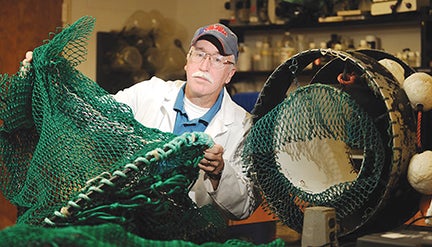UM biology professor aims to reduce shark deaths
Published 12:00 pm Friday, July 1, 2016

- University of Mississippi Professor of Biology Glenn Parsons is researching ways to reduce shark deaths from accidental catches.
By Michael Newsom
University of Mississippi
Fishermen unintentionally catch millions of sharks each year, and many don’t survive the physical stress of being reeled in, but University of Mississippi biology professor Glenn Parsons is designing a device that could prevent them from ever being hooked.
Accidental catches, referred to as “bycatch”, are a nuisance for commercial and recreational fishermen who are usually after tuna, swordfish and other seafood instead. The problem threatens to upset the ocean’s ecosystem, in which sharks play a major role but are dying in large numbers.
Parsons recently began testing a prototype and expects to make several trips into the Gulf of Mexico to fine-tune it. If his “entangling leader” device is successful, fisherman may not have to handle sharks, which have roamed the ocean mostly unchanged for some 400 million years.
“Commercial fisherman don’t want to catch these sharks,” Parsons said. “It’s dangerous to handle them. It takes time away from fishing and they also damage their gear. They’d rather not hook them at all.”
100M sharks killed each year
Some experts estimate that as many as 100 million sharks are killed each year. Many of them are larger, open ocean-dwelling sharks such as hammerheads, makos, tigers, great whites and others.
The deaths prompted the National Oceanic and Atmospheric Administration, which is working on a National Bycatch Strategy for sharks and other species, and the National Marine Fisheries Service to award research funds to find solutions. Parsons has received a $120,000 federal grant to develop his device and has an online crowdfunding campaign for his graduate students’ research.
The problem with bycatch isn’t that fish are simply hooked; rather it’s that the physical stress of fighting the reel, or being on the line for as long as six hours and then being hauled into the boat, that can kill them. Even if they’re released after many hours on the line, the outcome usually still isn’t good.
“Mostly everyone agrees that a huge percentage of those sharks die,” Parsons said.
Unique design
Parsons’ entangling leader has several loops of line near the hook. The design is based on the idea that the way sharks eat their food is much different than tuna or swordfish.
Sharks have larger, sharper teeth that they use for slicing prey into manageable pieces before swallowing them. Tuna, which have small teeth, and swordfish, which only have a rough a gripping surface along the edges of their mouths, both hold their food only long enough to swallow it whole.
The theory is that the loop design allows tuna and swordfish to take the bait and be hooked, but sharks would be prevented from doing the same.
“When a typical fish, one without sharp, cutting teeth, takes it, those loops will just spool out and hopefully the fish will be captured,” Parsons said. “When a shark takes it, the teeth entangle in the loops and that either breaks it immediately or it compromises the integrity of the line, so when they pull on it — and a big shark can pull like the dickens — it pops and they swim away.”
Testing in the Gulf
Recently, Parsons and his graduate assistants left from Destin, Florida, and ventured into the Gulf of Mexico to test the leader. Using a GoPro camera submerged near the hook, the Ole Miss team observed that for every shark that took the bait, about 10 looked at it and swam away. The ones that actually took the bait also broke the leader, Parsons said.
“The initial tests were really good,” Parsons said. “We have caught the larger sport fish, but the sharks break off.”
Further testing could determine if the bait is still attractive to other fish with the loop device in place.





